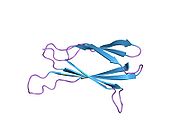
Monobody
Encyclopedia

Protein
Proteins are biochemical compounds consisting of one or more polypeptides typically folded into a globular or fibrous form, facilitating a biological function. A polypeptide is a single linear polymer chain of amino acids bonded together by peptide bonds between the carboxyl and amino groups of...
s that are able to bind to antigen
Antigen
An antigen is a foreign molecule that, when introduced into the body, triggers the production of an antibody by the immune system. The immune system will then kill or neutralize the antigen that is recognized as a foreign and potentially harmful invader. These invaders can be molecules such as...
s. Despite their name, they are not structurally related to antibodies, which makes them a type of antibody mimetic
Antibody mimetic
Antibody mimetics are organic compounds that, like antibodies, can specifically bind antigens, but that are not structurally related to antibodies. They are usually artificial peptides or proteins with a molar mass of about 3 to 20 kDa...
. They are being developed by Adnexus, a biotechnology company which has been part of Bristol-Myers Squibb
Bristol-Myers Squibb
Bristol-Myers Squibb , often referred to as BMS, is a pharmaceutical company, headquartered in New York City. The company was formed in 1989, following the merger of its predecessors Bristol-Myers and the Squibb Corporation...
since 2007. The monobody angiocept (CT-322), a VEGF receptor antagonist
Receptor antagonist
A receptor antagonist is a type of receptor ligand or drug that does not provoke a biological response itself upon binding to a receptor, but blocks or dampens agonist-mediated responses...
, has entered Phase II clinical trial
Clinical trial
Clinical trials are a set of procedures in medical research and drug development that are conducted to allow safety and efficacy data to be collected for health interventions...
s investigating the treatment of glioblastoma in October 2007. It is also being studied for the treatment of other types of cancer, such as non-small cell lung cancer and colorectal cancer
Colorectal cancer
Colorectal cancer, commonly known as bowel cancer, is a cancer caused by uncontrolled cell growth , in the colon, rectum, or vermiform appendix. Colorectal cancer is clinically distinct from anal cancer, which affects the anus....
.
Structure
Monobodies consist of 94 amino acids and have a molecular massMolecular mass
The molecular mass of a substance is the mass of one molecule of that substance, in unified atomic mass unit u...
of about 10 kDa
KDA
KDA may refer to:* Karachi Development Authority* Kongsberg Defence & Aerospace* Kotelawala Defence Academy* Kramer Design Associates* Lithium diisopropylamide, KDA is the potassium analogue of lithium diisopropylamideOr kDa may refer to:...
, fifteen times smaller than an IgG type antibody and comparable to the size of a single variable domain of an antibody. They are based on the structure of human fibronectin
Fibronectin
Fibronectin is a high-molecular weight glycoprotein of the extracellular matrix that binds to membrane-spanning receptor proteins called integrins. In addition to integrins, fibronectin also binds extracellular matrix components such as collagen, fibrin and heparan sulfate proteoglycans...
, more specifically on its tenth extracellular
Extracellular
In cell biology, molecular biology and related fields, the word extracellular means "outside the cell". This space is usually taken to be outside the plasma membranes, and occupied by fluid...
type III domain
Fibronectin type III domain
The Fibronectin type III domain is an evolutionary conserved protein domain that is widely found in animal proteins. The fibronectin protein in which this domain was first identified contains 16 copies of this domain. The domain is about 100 amino acids long and possesses a beta sandwich...
. This domain has a structure similar to antibody variable domains, with seven beta sheet
Beta sheet
The β sheet is the second form of regular secondary structure in proteins, only somewhat less common than the alpha helix. Beta sheets consist of beta strands connected laterally by at least two or three backbone hydrogen bonds, forming a generally twisted, pleated sheet...
s forming a barrel and three exposed loops on each side corresponding to the three complementarity determining region
Complementarity determining region
Complementarity determining regions are regions within antibodies or T cell receptors where these proteins complement an antigen's shape. Thus, CDRs determine the protein's affinity and specificity for specific antigens...
s. Monobodies lack binding sites for metal ions and the central disulfide bond
Disulfide bond
In chemistry, a disulfide bond is a covalent bond, usually derived by the coupling of two thiol groups. The linkage is also called an SS-bond or disulfide bridge. The overall connectivity is therefore R-S-S-R. The terminology is widely used in biochemistry...
.
Monobodies with specificity for different proteins can be tailored by modifying the loops BC (between the second and third beta sheets) and FG (between the sixth and seventh sheets).

